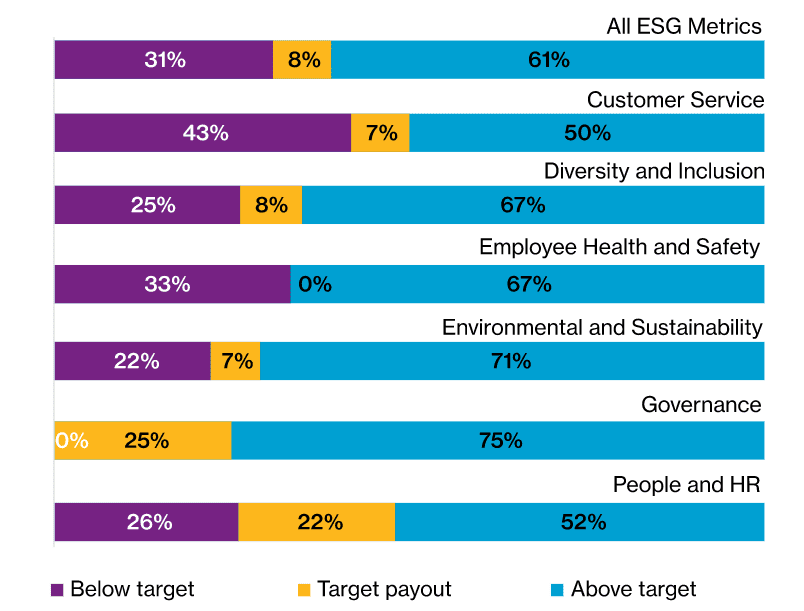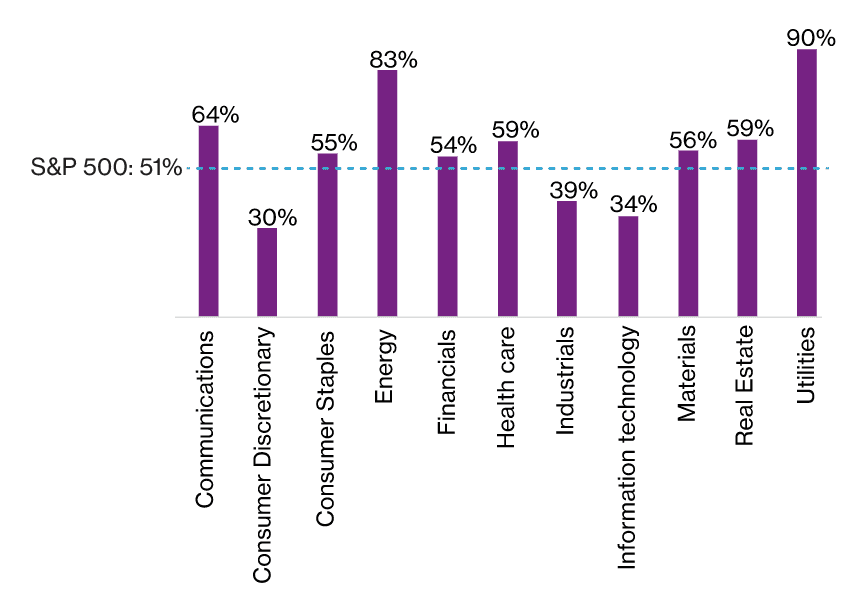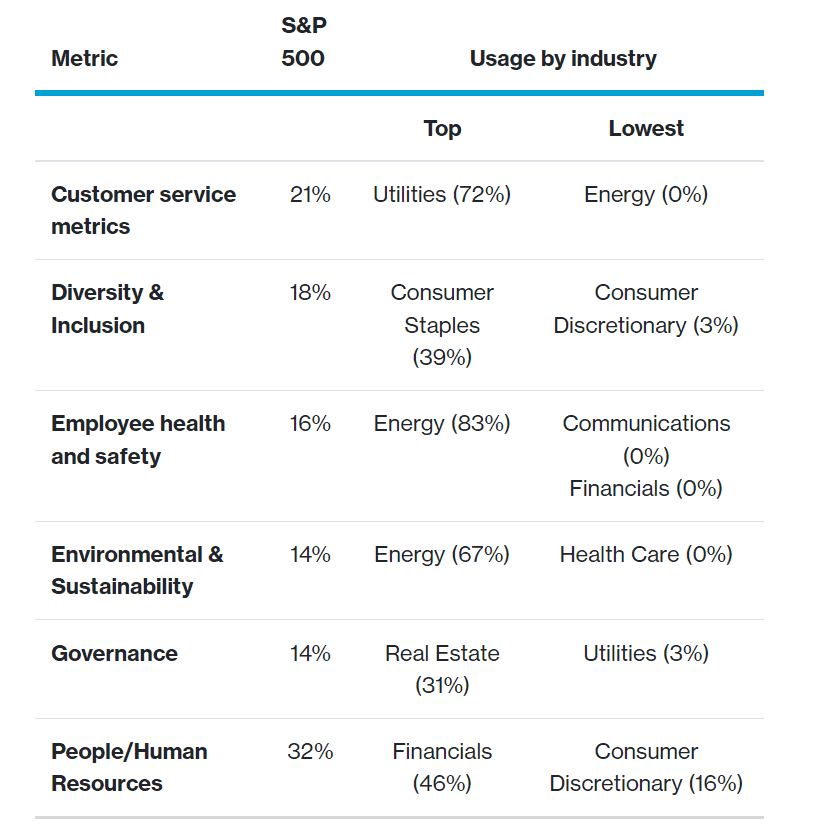The ongoing coronavirus pandemic has brought human capital and ESG issues to the forefront of most companies’ responses. But most S&P 500 companies still have work to do, our research finds.
The ongoing coronavirus pandemic has brought the issues of employee safety and engagement, community support, compliance and stakeholder communications to the forefront of most companies’ responses. S&P 500 companies are well on their way to integrating ESG in their compensation and human capital governance programs, but there is still work to do to meet the increasing demands of stakeholders.
A slim majority of S&P 500 companies use environmental, social and governance (ESG) metrics as part of their compensation evaluations, Willis Towers Watson research finds. This comes at a time when public statements of support from major business leaders and investors suggest that these metrics are poised for even greater adoption.
Just over half (51%) of S&P 500 companies use ESG metrics in their incentive plans, with 50% including it in annual incentive programs (AIPs), just released research by Willis Towers Watson’s Global Executive Compensation Analysis team (GECAT) confirmed. However, only 4% use ESG metrics for long-term incentive programs (LTIP).
Willis Towers Watson believes that ESG is primed for greater acceptance and adoption for several reasons. Forward-looking disclosures (what was enacted for 2019 and will be published in full during the 2020 season), indicate that several companies will be incorporating ESG into their plans for the first time. Likely ESG categories that will be added include diversity and inclusion (D&I), people/HR and governance categories, or environmental/sustainability metrics for companies in industries where they weren’t traditionally applied.
Major institutional investors such as BlackRock and State Street have also amended voting guidelines calling upon companies to pay more attention to ESG and communicate how they are incorporating it into governance practices. This is part of an ongoing evolution which gained traction following the groundbreaking 2019 message delivered by the Business Roundtable which committed to delivering value to customers, employees, suppliers and communities and shareholders.
With a growing segment of the business and investment community on board with ESG, quantifiable metrics are going to be increasingly important as organizations grapple with how to seamlessly integrate ESG into their human capital and compensation strategies, and then simply and effectively communicate their progress to stakeholders.
AIP usage
ESG is most commonly applied to AIP, as Willis Towers Watson’s GECAT research confirmed. Most standalone metrics make up 10% of AIP, but because some companies use multiple metrics, the typical weighting is between 15%-18%. The range, however, can be between 5%-40% of AIP measures.
Many of these ESG metrics have been used for a fairly long time (e.g., employee health and safety and customer service) and it will be interesting to see how other measures such as diversity and environmental impact evolve as they are increasingly seen as material from the perspective of institutional investors. There is a wide variation of usage and applications of metrics. Customer service, environmental and sustainability and safety are more commonly defined as weighted metrics while governance and HR-related metrics are usually factored into individual performance evaluations. The most common AIP weightings include a 10% weighting for: customer service, environmental and stability, people and HR, employee health and safety, and governance; and a 5% weighting for D&I.
These customized ESG applications have resulted in nearly 70% of weighted ESG annual incentive metrics being paid out at target or above (Figure 1) for S&P 500 companies using them in AIPs.

ESG adoption for LTI
ESG usage for long-term incentives (LTI) is a scant 4% of those incorporating them into incentive plans in comparison with AIP adoption, according to the Willis Towers Watson research. Perhaps this is tied to the traditional viewpoint that LTIs should be stock-return focused (appreciation for restricted stock and options, total shareholder return for performance awards). Alternatively, there has been a general viewpoint that LTI should focus on financial metrics while non-financial measurements are better suited in AIPs. The general consensus is that you drive changes in behavior by using shorter measurement cycles and the impact will be measured collectively using LTI tied to shareholder return. We anticipate that companies may increasingly incorporate some ESG metrics within LTIs, particularly environmental measures with long-term objectives that may be difficult to meaningful change on an annual basis.
Incentives by industry
The general application of ESG (Figure 2), as well as use of specific ESG metrics (Figure 3), have varied according to the targeted needs and long-term practices within industries. For instance, utilities have used customer service metrics, and the oil and gas industry, safety and environmental factors. Usage also depends upon an interpretation of ESG factors: a company with a progressive ESG policy might consider employee health and safety more of a wellness issue, but wouldn’t place workplace fatalities or injuries in the same category. Another company might include fatalities or injuries as part of ESG.
Despite the prevalence of certain industries to favor certain metrics, we’re likely to see a broader use of ESG metrics for industry agnostic categories such as D&I and employee engagement.


Progress is evident, there’s still work to do
The Willis Towers Watson findings indicate that S&P 500 companies are well on their way to integrating ESG in their compensation and human capital governance programs, but there is still work to do. Although a slim majority measure and pay using ESG, just over 15% of S&P 500 companies use hard, quantifiable metrics to measure their performance. Consequently, ESG is applied subjectively for most companies. As interest in integrating ESG grows among S&P 500 stakeholders, spurred on by the Business Roundtable and institutional investors’ interest in improved use and disclosure of how pay is impacted, the use and measurement of metrics will need to improve. Companies would benefit by providing expanded disclosures that more specifically detail how ESG impacts pay.
This article was first published at wtwco.com.
Download the publication at the right sidebar to read more.
Photo by David Di Veroli on Unsplash.

 5.0
5.0 





















